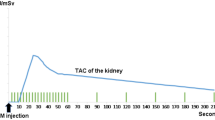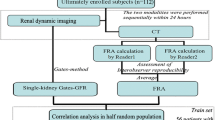Abstract
Purpose
To investigate whether triphasic CT with a simplified Patlak plot can be used in clinical practice for the estimate of split kidney glomerular filtration rate (SKGFR).
Materials and methods
The animal experiment included 15 rabbits that underwent 40 dynamic contrast-enhanced CT scans of the kidneys with 1.5 s time interval. Patlak-derived SKGFR was obtained using standard forty-point, two-point (unenhanced phase, arterial phase t α, and portovenous phase t β), and a modified two-point (MTP) (unenhanced, t α, t β, and a virtual t τ [t τ = (t α + t β)/2]) image data, respectively. The MTP-Patlak plot approach was then validated in 13 patients who underwent a triphasic renal contrast-enhanced CT examination. SKGFR measured by 99mTc-DTPA clearance was as a standard reference.
Results
MTP-Patlak significantly reduced input function errors than two-point Patlak (21.1 ± 16.2 % vs 30.8 ± 15.2 %, p < 0.01) and showed good concordance with standard Patlak for measurement of SKGFR in animal experiment (1.20 ± 0.38 mL/g/min vs 1.51 ± 0.43 mL/g/min; linear correlation coefficient r = 0.87, p < 0.001). Human study showed that mean SKGFR was 45.7 mL/min (range, 26.5–86.2 mL/min) obtained from 99mTc-DTPA, and 38.2 mL/min (range, 18.6–79.3 mL/min) obtained from triphasic CT using MTP-Patlak plot. Linear correlation between the two methods was r = 0.75 (p < 0.01). The mean difference between SKGFRs as determined with the two methods was 7.4 ± 9.0 mL/min.
Conclusion
The MTP-Patlak approach, featured with simplicity, is feasible in a clinically indicated CT examination for the evaluation of split renal function.






Similar content being viewed by others
References
Spital A, Abuelo JG (2006) Measured and estimated glomerular filtration rate. New Engl J Med 355(10):1069; author reply -70
Eirin A, Ebrahimi B, Zhang X, et al. (2012) c. Circ Cardiovasc Interv 5(5):720–728
La Batide-Alanore A, Azizi M, Froissart M, Raynaud A, Plouin PF (2001) Split renal function outcome after renal angioplasty in patients with unilateral renal artery stenosis. J Am Soc Nephrol: JASN 12(6):1235–1241
Claudon M, Durand E, Grenier N, et al. (2014) Chronic urinary obstruction: evaluation of dynamic contrast-enhanced MR urography for measurement of split renal function. Radiology 273(3):801–812
Daghini E, Juillard L, Haas JA, et al. (2007) Comparison of mathematic models for assessment of glomerular filtration rate with electron-beam CT in pigs. Radiology 242(2):417–424
Aprile C, Saponaro R, Villa G, et al. (1986) Assessment of split renal function with 99mTc-aprotinin. Eur J Nucl Med 12(1):37–40
Perrone RD, Steinman TI, Beck GJ, et al. (1990) Utility of radioisotopic filtration markers in chronic renal insufficiency: simultaneous comparison of 125I-iothalamate, 169Yb-DTPA, 99mTc-DTPA, and inulin. The modification of diet in renal disease study. Am J Kidney Dis 16(3):224–235
Effersoe H, Rosenkilde P, Groth S, Jensen LI, Golman K (1990) Measurement of renal function with iohexol. A comparison of iohexol, 99mTc-DTPA, and 51Cr-EDTA clearance. Investig Radiol 25(7):778–782
Alexander K, Authier S, del Castillo JR, et al. (2010) Patlak plot analysis CT-GFR for the determination of renal function: comparison of normal dogs with autologous kidney transplant dogs. Contrast Media Mol Imaging 5(3):133–139
Helck A, Schonermarck U, Habicht A, et al. (2014) Determination of split renal function using dynamic CT-angiography: preliminary results. PLoS One 9(3):e91774
Hackstein N, Wiegand C, Rau WS, Langheinrich AC (2004) Glomerular filtration rate measured by using triphasic helical CT with a two-point Patlak plot technique. Radiology 230(1):221–226
Reiner CS, Goetti R, Eberli D, et al. (2012) CT perfusion of renal cell carcinoma: impact of volume coverage on quantitative analysis. Investig Radiol 47(1):33–40
Lemoine S, Papillard M, Belloi A, et al. (2011) Renal perfusion: noninvasive measurement with multidetector CT versus fluorescent microspheres in a pig model. Radiology 260(2):414–420
Hackstein N, Bauer J, Hauck EW, et al. (2003) Measuring single-kidney glomerular filtration rate on single-detector helical CT using a two-point Patlak plot technique in patients with increased interstitial space. AJR Am J Roentgenol 181(1):147–156
Herts BR, Sharma N, Lieber M, et al. (2009) Estimating glomerular filtration rate in kidney donors: a model constructed with renal volume measurements from donor CT scans. Radiology 252(1):109–116
Hamed MA (2014) New advances in assessment of the individual renal function in chronic unilateral renal obstruction using functional CT compared to 99mTc-DTPA renal scan. Nuclear Med Rev Cent East Eur 17(2):59–64
Soga S, Britz-Cunningham S, Kumamaru KK, et al. (2012) Comprehensive comparative study of computed tomography-based estimates of split renal function for potential renal donors: modified ellipsoid method and other CT-based methods. J Comp Assist Tomogr 36(3):323–329
Patlak CS, Blasberg RG, Fenstermacher JD (1983) Graphical evaluation of blood-to-brain transfer constants from multiple-time uptake data. J Cereb Blood Flow Metab 3(1):1–7
Tsushima Y, Blomley MJ, Kusano S, Endo K (1999) Use of contrast-enhanced computed tomography to measure clearance per unit renal volume: a novel measurement of renal function and fractional vascular volume. Am J Kidney Dis 33(4):754–760
Lerman LO, Flickinger AL, Sheedy PF 2nd, Turner ST (1996) Reproducibility of human kidney perfusion and volume determinations with electron beam computed tomography. Investig Radiol 31(4):204–210
Hackstein N, Heckrodt J, Rau WS (2003) Measurement of single-kidney glomerular filtration rate using a contrast-enhanced dynamic gradient-echo sequence and the Rutland-Patlak plot technique. J Magn Resonance Imaging: JMRI 18(6):714–725
Aprile C, Saponaro R, Solerte SB (1986) Determination of glomerular filtration rate by Gates’ method. J Nuclear Med 27(10):1644–1645
Bokacheva L, Rusinek H, Zhang JL, Chen Q, Lee VS (2009) Estimates of glomerular filtration rate from MR renography and tracer kinetic models. J Magn Resonance Imaging: JMRI 29(2):371–382
Zhang YD, Wu CJ, Zhang J, et al. (2015) Feasibility study of high-resolution DCE-MRI for glomerular filtration rate (GFR) measurement in a routine clinical modal. Magn Resonance Imaging 33(8):978–983
Michaely HJ, Sourbron SP, Buettner C, et al. (2008) Temporal constraints in renal perfusion imaging with a 2-compartment model. Investig Radiol 43(2):120–128
Zhang YD, Wang J, Zhang J, Wang X, Jiang X (2014) Effect of iodinated contrast media on renal function evaluated with dynamic three-dimensional MR renography. Radiology 270(2):409–415
Vivier PH, Storey P, Rusinek H, et al. (2011) Kidney function: glomerular filtration rate measurement with MR renography in patients with cirrhosis. Radiology 259(2):462–470
Annet L, Hermoye L, Peeters F, et al. (2004) Glomerular filtration rate: assessment with dynamic contrast-enhanced MRI and a cortical-compartment model in the rabbit kidney. J Magn Resonance Imaging: JMRI 20(5):843–849
Buckley DL, Shurrab AE, Cheung CM, et al. (2006) Measurement of single kidney function using dynamic contrast-enhanced MRI: comparison of two models in human subjects. J Magn Resonance Imaging: JMRI 24(5):1117–1123
Sourbron SP, Michaely HJ, Reiser MF, Schoenberg SO (2008) MRI-measurement of perfusion and glomerular filtration in the human kidney with a separable compartment model. Investig Radiol 43(1):40–48
Author information
Authors and Affiliations
Corresponding author
Ethics declarations
Funding
This study was funded by the National Natural Science Foundation of China (NSFC; Grant 81301191) and by the Priority Academic Program Development of Jiangsu Higher Education Institutions (PAPD; JX10231801).
Conflict of Interest
All authors of this study declare that they have no conflict of interest.
Ethical Approval
All procedures performed in studies involving human participants were in accordance with the ethical standards of the institutional and/or national research committee and with the 1964 Helsinki declaration and its later amendments or comparable ethical standards.
Research Involving Animal Participants
All applicable international, national, and/or institutional guidelines for the care and use of animals were followed.
Rights and permissions
About this article
Cite this article
Zhang, YD., Xue, CQ., Wu, CJ. et al. Feasibility of triphasic CT with a modified two-point Patlak plot to determine spit kidney glomerular filtration rate in clinical practice. Abdom Radiol 42, 226–235 (2017). https://doi.org/10.1007/s00261-016-0858-9
Published:
Issue Date:
DOI: https://doi.org/10.1007/s00261-016-0858-9




